Iran’s elite Revolutionary Guards have deployed forces to three provinces to put down an eruption of anti-government unrest after six days of protests that have rattled the clerical leadership and left 21 people dead.
The protests, which began last week out of frustration over economic hardships suffered by the youth and working class, have evolved into a rising against the powers and privileges of a remote elite, especially Supreme Leader Ayatollah Ali Khamenei.
Defying threats from the judiciary of execution if convicted of rioting, protests resumed after nightfall on Wednesday with hundreds hitting the streets of Malayer in Hamadan province chanting: “People are begging, the supreme leader is acting like God!”
Videos carried by social media showed protesters in the northern town of Nowshahr shouted “death to the dictator” – an apparent reference to the ayatollah.
In a sign of official concern about the resilience of the protests, the Revolutionary Guards commander, Major General Mohammad Ali Jafari, said he had dispatched forces to Hamadan, Isfahan and Lorestan provinces to tackle “the new sedition”. Most of the casualties among protesters have occurred in those regions of the sprawling Islamic Republic.
The Revolutionary Guards, the sword and shield of Iran’s Shia theocracy, were instrumental in suppressing an uprising over alleged election fraud in 2009 in which dozens of mainly middle-class protesters were killed. Ayatollah Khamenei condemned that unrest as “sedition”.
In a state-sponsored show of force aimed at countering the outpouring of dissent, thousands of Iranians also took part in pro-government rallies in several cities on Wednesday morning. State television broadcast live footage of rallies in cities across the country, where marchers waved Iranian flags and portraits of the ayatollah.
Pro-government marchers chanted, "the blood in our veins is a gift to our leader [Khamenei]," and, "we will not leave our leader alone". They accused the United States, Israel and Britain of inciting protests, shouting, "the seditionist rioters should be executed!"
In the Shia holy city of Qom, pro-government demonstrators chanted “death to American mercenaries”. On Tuesday, the 78-year-old Ayatollah Khamenei had accused Iran’s adversaries of fomenting the protests.
‘Such respect’
US president Donald Trump, who has sought to isolate the Tehran leadership, reversing the conciliatory approach of predecessor Barack Obama, said Washington would throw its support behind the protesters at a suitable time.
"Such respect for the people of Iran as they try to take back their corrupt government. You will see great support from the United States at the appropriate time!" Mr Trump wrote in the latest of a series of tweets on Iran's turmoil.
The protests seem to be spontaneous, without a clear leader, cropping up in working-class neighbourhoods and smaller cities, but the movement seems to be gaining traction among the educated middle class and activists who spearheaded the 2009 revolt.
More than 100 Iranian woman activists voiced support for a new uprising in a statement on Wednesday. Several prominent Iranian lawyers, including Nobel Peace Prize laureate Shirin Ebadi, urged Tehran to respect people’s right to freedom of assembly and expression, guaranteed under the constitution.
Some labour unions as well as minority Kurdish opposition groups have also thrown their weight behind the protests.
In Geneva, the UN human rights chief urged Iran to rein in security forces to avoid further violence and respect the right of protesters to freedoms of expression and peaceful assembly.
Zeid Ra’ad al-Hussein, UN High Commissioner for Human Rights, said hundreds of Iranians had been arrested in the past week, and called for “thorough, independent and impartial investigations of all acts of violence”.
– Reuters













